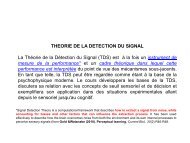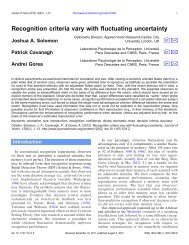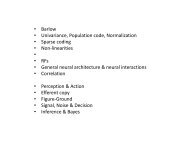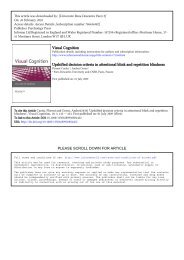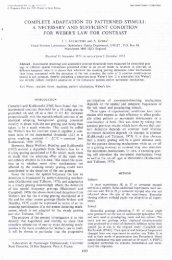Diapositive 1 - Andrei GOREA
Diapositive 1 - Andrei GOREA
Diapositive 1 - Andrei GOREA
- No tags were found...
Create successful ePaper yourself
Turn your PDF publications into a flip-book with our unique Google optimized e-Paper software.
INTRODUCTION A LA PSYCHOPHYSIQUE*<strong>Andrei</strong> Gorea*The science regulating the choice of stimuli, the methods and experimental designs meantto answer specific questions concerning the mechanisms/processes underlying thesensations/perceptions evoqued by external events.*La science régulant le choix des stimuli, des méthodes et des plans expérimentauxpermettant de répondre à une question précise en rapport avec les processus sous-jacentsaux sensations/perceptions induites par le monde extérieur.
PLAN DU COURS(I. Histoire)II. Stimuli & Méthodes Stimuli élémentaires et leurs paramètres Visibilité, enveloppe spatio-temporelle de la visibilité Autre stimuli, autres problématiques Seuil, Bruit, Fonction Psychométrique et TransductionIII. Méthode de mesure de seuils Classification des méthodes et des tâches Fonction psychométrique Paradigmes oui/non et choix forcé Méthodes de mesure de seuil‣ Méthodes des limites‣ Ajustement‣ Stimuli constants‣ Fonction psychométrique‣ Méthodes adaptative‣ ‘Scaling’ et ‘magnitude estimation’ Plans expérimentaux Quelques paradigmes classiquesIV. Un peu de pratiqueV. Théorie de la Détection du Signal
II. STIMULI « ELEMENTAIRES »En Psychophysique, le Stimuli doivent être précisément définis……leur forme, leur taille, leur couleur, leur orientation, leur contraste(intensité)……leur fréquence temporelle/spatiale, leur disparité binoculaire, leurvitesse…
Visual AngleTT/2 T/2 tanqT2 d d'q arctan2Td d' Rule of the thumb:q = 57.3/d
The Snellen charts (1862)
Dots and BarsWeber’s ContrastL 0 -DLL 0 +DLL 0C WEBER = DLL 0
Gaussian blobsWeber’s Contrasts1 x mexp22 2s2C WEBER = DLL 0LL 0 +DLL ODLG [m, s]x
dBdB = 20log 10 (DI / I)DI = I10 dB/201dB DI/I = 1.122
Vernier AcuityPierre Vernier (1580-1637) mathématicien françaisDx Dx Seuil = 5’’
Minimum separabileDx Seuil ≈ 36’’Dx
AmplitudeSpatial Frequency (Gratings)Michelson ContrastSF [cycles/degree]1,510,5AmplitudeL MAXL 0C Michelson =0-0,5-1-1,50 5 10 15 20 25 30AngleL(x,t) = L 0 [1 + mcos(2f x 2w t )]L minL MAX - L minL MAX + L min=AL 0
Elements of Fourier Analysis2Af y2A0f x
1f, A3f, A/3f y0f xSf y0f x
f y0f xf y0f x1f, 2A 3f, 2A/3 5f, 2A/5
Output amplitudeDans un système linéaire, mesurer l’amplitude du signal de sortie du système pour uneamplitude d’entrée constante (l’approche de l’ingénieur) équivaut à mesurer l’amplitudeentrante requise afin d’obtenir un signal de sortie constant (le seuil; l’approche dupsychophysicien).Variable Output amplitudeLow-passBand-passFonction de transfert d’unelentilleConstant Input amplitudeFrequency (c/deg)
S (= 1/C q )The Human Contrast Transfer Function (CSF)CClassical acuityminimum separabile( 50 c/deg)≈ 36’’SF?
Gratings move…Direction, speed, velocitySpeed deg/sDirection degVelocity = Speed + DirectionSpeed [deg/s] =Space [deg]Time [s]=TF [cycles/s]SF [cycles/deg]
6 Hz1 Hz16 Hz22 Hz4 c/°0.5 c/°16 c/°22 c/°Robson, 1966THJRESHOLD&SENSITIVITYSensitivity = 1/ThresholdKelly, 1978Temporal Frequencycycles/s Hz
Equiluminant gratingsExamples of gratings with S-cone positive (left) and S-cone negative (right) contrast.
Chromatic grating & sensitivityContrast sensitivity as a function of spatialfrequency for the red-green grating (□; 526,602 nm) and a green monochromatic grating(○; 526 nm).Contrast sensitivity as a function of spatialfrequency for the blue-yellow grating (□;470, 577 nm) and a yellow monochromaticgrating (○; 577 nm).Contrast sensitivities asa function of spatialfrequency for a blueyellowgrating (◊; 470,577 nm) and a redgreengrating (□; 602,526 nm).Mullen, K.T. (1985) J. Physiol. 359, 381-400
Color vision testsIsihara plates
FILTRAGE MULTIECHELLEFaceSFFaceSF + Ori
FILTRAGE MULTIECHELLE
FILTRAGE MULTIECHELLE
LuminanceMach bandsxBrightness
(a) Image 1-Dluminance profile(b) Fouriertransform of theimage (1-D Fourierspectrum)(c) Human SFsensitivity(d) Dot product of(b) & (c)(e) ‘Reconstructedimage 1-Dluminance profile(inverse Fouriertransform)
Mach bands
An illusion by Vasarely, left, and a bandpassfiltered version, right.
The RF is equivalent to the system’s Impulse ResponsePHYSICAL SPACERECEPTIVEFIELDIncoming lightPhotoreceptorsDans un système linéairerétinotopique,AxonsNeuronsLa représentation d’unensemble de points (image)par un seul neuroneRETINOTOPICAL SPACERecording siteest strictement identique à lareprésentation d’un pointdans l’espace physiquePhotoreceptorsPHYSICAL SPACEIncoming lightpar l’ensemble desneurones qui le traitent.AxonsNeuronsIMPULSERESPONSERecording siteRETINOTOPICAL SPACE
CONVOLUTION1 1 1 1 2 3 4 5 5 5 51 1 1 1 2 3 4 5 5 5 5-1 3 -1S S XChamp récepteur Eh 1 1 0 2 3 4 6 5 5E(X) = Entrée (fct. de X)S(X) = Sortie (fct. de X)CR = h(x) = Réponse Implle (fct. de x)E(X x) h(x)dx S XS-1 3 -1Réponse impulsionnelle3 -1-1 3 -1-1 3 -1-1 3 -1-2 6 -2-3 9 -3-4 12 -4-5 15 -5-5 15 -5 Eh E(X) h(Xx) dx-5 15 -5-5 151 1 0 2 3 4 6 5 5
Plaids(tartans)f yf yf y0 f xf x0 0 f xf y+ +f y0 f x0f x
Plaids in motionSpeed [deg/s] =Space [deg]Time [s]=TF [cycles/s]SF [cycles/deg]
Amplitude (dB)White noisePink noiseAppearanceS(f) 1 / f 1S(f) 1 / f 0= k1-DFourierspectrum1 10 100Frequency (Hz or c/deg)1 10 100Pink noise or 1/f noise is a signal or process with a frequency spectrum such that the power spectraldensity is proportional to the reciprocal of the frequency. For pink noise, each octave carries an equalamount of noise power. The name arises from being intermediate between white noise (1/f0) and rednoise (1/f2, more commonly known as Brownian noise)
Filtered noiseAppearance2-D Fourierspectrum1-D FourierspectrumWhiteFiltered with a 0.5octave* isotropic filter* Octave: Frequency doubling
Figure 4. Illustration of spatial whitening. (a) A natural image whose amplitude spectrum, plotted in (c), fallsapproximately as “1/F” on log–log axes with a slope of j1.4. Whitening the amplitude spectrum produces an image(b) that appears sharpened, but otherwise structurally quite similar. (d) The amplitude spectrum of the whitenedimage has approximately the same amplitude at all spatial frequencies and a resultant spectral slope close to 0.The rms contrasts of the source and whitened images have been fixed at 0.25.Bex, Solomon & Dakin, (2009). Journal of Vision, 9(10):1, 1–19.
White noiseNatural ImageRoot mean square ContrastCrmsn 2L Li1i 0n
ms Contrast(root mean square)Crmsn 2 Li L0i1n
Contraste au SeuilSF gratings in NoiseAssessing the internal noiseÉlévation du SeuilNoise rms Contrast
A visual assessment chartconsisting of letters in noise thatis designed to test for someneural deficits while beingunaffected by optical deficits.Denis Pelli (NYU, USA) & John Hoepner(Depart. of Opthalmology, Health ScienceCenter, Syracuse, NY, USA.)http://viperlib.york.ac.uk/scripts/PortWeb.dll?field=keywords&op=contains&value1=noise&template=thumbs_details&join=or&field2=imageDescription&op=contains&value2=noise&sorton=Filename&catalog=proto1&submit2.x=0&submit2.y=0&submit2=Search
Random Dots Stereograms(RDS – Julesz, 1961)I. Create a random dot image.II. Copy image side by side.The Random Dot Stereogram is ready.III. Select a region of one image.IV. Shift (horizontally) this regionand fill in the blank space leftbehind with the random dotsto be replaced ahead.To “reveal” the “hidden” squarethe brain presumably computesthe cross-correlation betweenthe 2 images.
Binocular disparityPpp’Binocular disparity x – x’ [deg]Figure 1. The binocular fusion problem: in the simple case of the diagram shown on the left,there is no ambiguity and stereo reconstruction is a simple matter. In the more usual case shownon the right, any of the four points in the left picture may, a priori, match any of the four points inthe right one. Only four of these correspondences are correct, the other ones yielding theincorrect reconstructions shown as small grey discs
AmplitudeAmplitude Modulation (AM) Contrast-Contrast (2nd order modulations)CC Michelson =C MAX - C minC MAX + C minhttp://viperlib.york.ac.uk/scripts/PortWeb.dll?field=keywords&op=contains&value1=second+order+motion&template=thumbs_details&join=or&field2=imageDescription&op=contains&value2=second+order+motion&sorton=Filename&catalog=proto1&submit2.x=41&submit2.y=12&submit2=Searchhttp://www.michaelbach.de/ot/lum_contrast-contrast/index.htmlC minC MAXx
Amplitude Modulation (AM)Contrast-Contrast
Other approaches… other stimuli…
Lois d’organisation
Figure-FondRubin, 1915
Figure-Fond
Figure-Fond
Necker cubeLuis Albert Necker, 1832
2D HIDDEN IMAGESort commun, Mouvement et Forme
Optic flawBiological motion
Hollow Mask
Light from above
Illusionshttp://www.michaelbach.de/ot/



